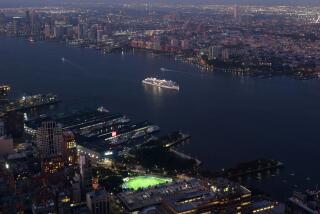Sailings That Give Meaning to Term, âShakedown Cruiseâ : Ships: Based on two recent debacles, consumers should be wary of booking voyages on newly renovated vessels.
When bad things happen on newly renovated cruise ships, a traveler wonders. And very bad things have happened recently on two reconditioned ships.
In early November, the problem ship was American Hawaii Cruisesâ Independence, plagued by reports of troubled plumbing, failing air-conditioning and scores of unhappy passengers cutting their Hawaiian cruises short. In mid-December it was the Cunard Lineâs famed Queen Elizabeth 2, crossing the Atlantic from England to New York with well-heeled passengers troubled by renovations still in progress, erupting toilets and (once the seas got rough) vomiting tradesmen.
Is this bad luck striking twice? Or are passengers paying a price for cruise lines that are in a hurry to get their revenue streams flowing again?
âWhen you take an older ship out of service and start really tearing it apart, I think what (often) happens is that things become apparent that were not anticipated,â says Michael Hannan, owner of San Marin Travel in Marin County and before that a 25-year veteran of the cruise industry. âOn the other hand, I think that the cruise line bears some responsibility to allow for that possibility when they schedule these dry dockings . . . Itâs probably the nature of companies to be optimistic.â
Cruise companies say theyâre being as realistic as they can and point out that a new or newly renovated ship is like a new house: Something is likely to go wrong somewhere, and it takes usage to find it.
Hannan and others agree that over the last two decades, theyâve seen more problems with renovated ships than new ones. And so, when Hannan has a client interested in a newly renovated ship, he recommends booking âthe fourth or fifth cruiseâ after return to the sea, âto allow some leeway.â
American Hawaii Cruisesâ Independence, a 398-cabin ship built in 1951 with transatlantic cruises in mind, went into dry dock at Newport News, Va., last July 19. Spokeswoman Nancy Loewenherz said that it was scheduled to return to service three months later on Sunday, Oct. 19.
Aiming to recast the vesselâs appearance to suit its tropical surroundings, the cruise line contracted for Newport News Shipyard and various subcontractors to redecorate, build new cabins, replace air-conditioning, upgrade plumbing and build new stairwells, among other things. Cost of the renovation was put at $30 million. (Before the ship left the yard, the shipyard and the cruise lineâs parent company got into a dispute, now in litigation, over the price tag.)
But the work on the shipâs interior steelwork turned out to be a bigger job than had been forecast, Loewenherz said, and the shipâs return to the sea was ultimately delayed four weeks, until Nov. 5. When it finally returned to sail from Honolulu, the Independence had 414 cabins (thus, a capacity of 828 passengers) and was close to full capacity. Passengers had paid $995 to $3,000 for a seven-day itinerary. Then came the problems.
Discontent ran high among passengers, and about 170 elected to disembark early, exiting the ship at port calls to Hilo on the second day and Kona on the third day.
Those who left early, Loewenherz said, were given a full refund plus accommodations on an island of their choice, depending on availability of hotel space and inter-island air fare. Some got rental cars as well. Those who stayed aboard got reimbursement checks for 50% of their fare on the last day of the cruise.
Since then, the ship has continued with its regular schedule and has served hundreds of cruisers.
The cruise of the QE2 a month later was a comparable experience. The Cunard Steamship Co., which owns the ship, had sent the 25-year-old QE2 to Blohm+Voss Shipyard in Hamburg, Germany, for $45 million in renovations--a dry-docking and top-to-bottom remodel that was to last Nov. 19 to Dec. 15. So it did. But subcontractorsâ cabin renovations lagged, and workmen followed the ship back to England.
When time came for the ship to sail from Southhampton, England, to New York on Dec. 17, subcontractorsâ workmen were still aboard renovating cabins. About 300 would-be passengers had been told in advance that they could not be accommodated; another 100 opted on the spot not to sail. That left about 600 passengers on the crossing (shipâs capacity is 1,800), and those who made the trip endured flooding toilets, brown running water and piles of construction materials.
Cunard offered the unlucky passengers full refunds (transatlantic fares range $1,995-$10,450 per person), a free five-day Atlantic crossing in 1995 and $375 in on-board spending credit.
But the shipâs troubles didnât end with its New York arrival Dec. 22. U.S. Coast Guard inspectors found numerous fire and safety violations before the ship was to head south on a Caribbean Christmas cruise, and by the time necessary repairs were made and the ship left port Dec. 24, the QE2 was about 25 hours late, a spokeswoman said.
The QE2 is now again on schedule, and the days of tumult have passed. But any cruise passenger who books a cruise immediately following a major renovation, on any cruise line, should be ready for the possibility of similar troubles.
More to Read
Sign up for The Wild
Weâll help you find the best places to hike, bike and run, as well as the perfect silent spots for meditation and yoga.
You may occasionally receive promotional content from the Los Angeles Times.







